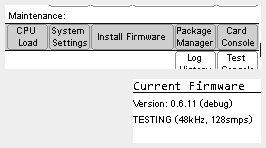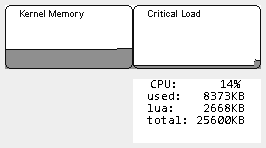This page is a DRAFT.
You can query the CPU load at any time from the admin menu.
CPU load will ‘‘usually’’ be the sum of the fixed costs of all units in use (plus ~3% of overhead). A unit’s cost does not depend on where you insert it except to the extent that mono vs stereo might affect it. In general expect, a stereo unit’s cost to be from 50% to 100% more than its mono version. The number of (local and global) connections does not matter.
Exceptions
In general, units are designed to have a fixed CPU cost that does not depend on their inputs. The cases where this is violated (in order of severity) are:
- Manual Grains: CPU load grows as more grains are overlapping (i.e. polyphony). This happens when you trigger grain production faster and/or increase grain duration.
- All random-access sample playing units and delay units with a speed control: L1/L2 cache misses caused by non-sequential access to sample memory will result in increased CPU load (stalling). Layman translation: Randomly jumping around in the buffer at audio rates, or playback at really high speeds (>10x). This forces the ER-301 to repeatedly query the RAM (slow) for necessary data because it is not in the L1/L2 memory cache (fastest).
Actual Measurements
Forum user a773 has compiled this listing of CPU load measurements for a selection of units: a773’s Unit CPU Load measurements

